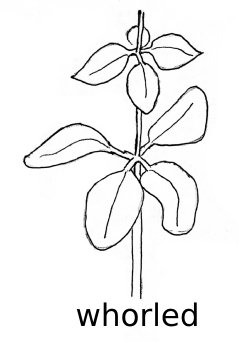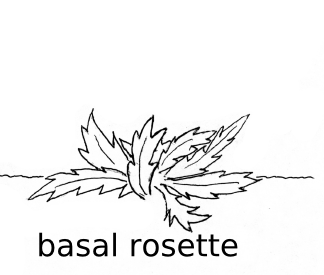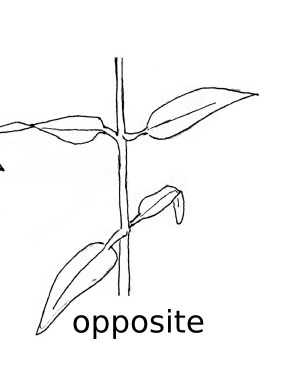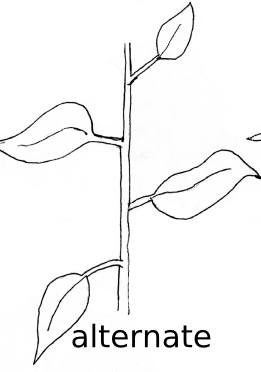
Answer
427.5k+ views
Hint: Phyllotaxy is the pattern of arrangement of leaves on the stem or branch. The basic arrangements we see in leaves, stems, axis or branches from our naked eyes that is phyllotaxy. It is necessary as the leaf gets enough space to grow. There are different types of phyllotaxy which will be discussed here.
Complete answer:
Phyllotaxy is usually of three types. Alternate phyllotaxy, opposite phyllotaxy and whorled phyllotaxy. The basic arrangements of leaves on a stem are opposite and alternate which is also known as spiral.
In an alternate type of phyllotaxy, a single leaf arises at each node in an alternate manner. Example- china rose, mustard, and sunflower plants. In opposite types of leaves arise at each node and lie opposite to each other as in plants like Calotropis and guava plants.
In whorled phyllotaxy if more than two leaves arise at a node and form a whorl, it is called whorled as in plants like alstonia. The whorled arrangement is fairly unusual on plants except for those with particularly short internodes. A basal whorl with a large number of leaves spread out in a circle is called rosette.
Distichous phyllotaxy is also called two-ranked leaf arrangement is a special case of either opposite or alternate leaf arrangement where the leaves on a stem are arranged in two vertical columns on opposite sides.
Tristichous phyllotaxy is the mode of arrangement of three leaves in one spiral. It is called a three-ranked arrangement. The arrangement of first, fourth, seventh, and tenth leaf remains in row while the third, sixth, ninth and twelfth in second row and second, fifth, eighth and eleventh in the third row. So, the angular divergence is
Note:
Plant shows arrangement of leaves to get proper sunlight, inflorescence of flower also grow better most plants show alternate phyllotaxy as it is most common phyllotaxy and the rarest one is whorled phyllotaxy. Opposite is also seen in many plants.




Complete answer:
Phyllotaxy is usually of three types. Alternate phyllotaxy, opposite phyllotaxy and whorled phyllotaxy. The basic arrangements of leaves on a stem are opposite and alternate which is also known as spiral.
In an alternate type of phyllotaxy, a single leaf arises at each node in an alternate manner. Example- china rose, mustard, and sunflower plants. In opposite types of leaves arise at each node and lie opposite to each other as in plants like Calotropis and guava plants.
In whorled phyllotaxy if more than two leaves arise at a node and form a whorl, it is called whorled as in plants like alstonia. The whorled arrangement is fairly unusual on plants except for those with particularly short internodes. A basal whorl with a large number of leaves spread out in a circle is called rosette.
Distichous phyllotaxy is also called two-ranked leaf arrangement is a special case of either opposite or alternate leaf arrangement where the leaves on a stem are arranged in two vertical columns on opposite sides.
Tristichous phyllotaxy is the mode of arrangement of three leaves in one spiral. It is called a three-ranked arrangement. The arrangement of first, fourth, seventh, and tenth leaf remains in row while the third, sixth, ninth and twelfth in second row and second, fifth, eighth and eleventh in the third row. So, the angular divergence is
Note:
Plant shows arrangement of leaves to get proper sunlight, inflorescence of flower also grow better most plants show alternate phyllotaxy as it is most common phyllotaxy and the rarest one is whorled phyllotaxy. Opposite is also seen in many plants.




Latest Vedantu courses for you
Grade 11 Science PCM | CBSE | SCHOOL | English
CBSE (2025-26)
School Full course for CBSE students
₹41,848 per year
EMI starts from ₹3,487.34 per month
Recently Updated Pages
Master Class 10 Science: Engaging Questions & Answers for Success

Master Class 10 Social Science: Engaging Questions & Answers for Success

Master Class 10 Maths: Engaging Questions & Answers for Success

Master Class 10 English: Engaging Questions & Answers for Success

Class 10 Question and Answer - Your Ultimate Solutions Guide

Master Class 9 General Knowledge: Engaging Questions & Answers for Success

Trending doubts
State and prove Bernoullis theorem class 11 physics CBSE

1 ton equals to A 100 kg B 1000 kg C 10 kg D 10000 class 11 physics CBSE

State the laws of reflection of light

One Metric ton is equal to kg A 10000 B 1000 C 100 class 11 physics CBSE

Difference Between Prokaryotic Cells and Eukaryotic Cells

1 Quintal is equal to a 110 kg b 10 kg c 100kg d 1000 class 11 physics CBSE




